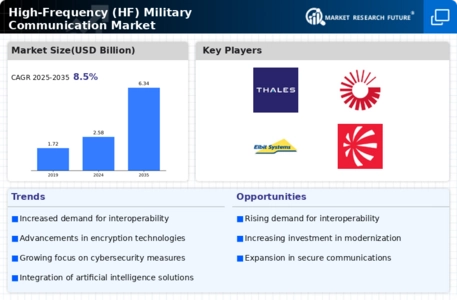Leading market players are investing heavily in research and development including developing advanced HF communication systems with features such as improved data rates, enhanced signal quality, and better resistance to interference. Market participants are also Adopting a variety of strategic tactics to increase their global footprint, with important market developments including Strategic Partnerships and Alliances, Customization, Integration Services, Cybersecurity Integration, new product launches, contractual agreements, mergers and acquisitions, and higher investments. To expand and survive in a more competitive and rising market climate, the High-Frequency (HF) Military Communication industry must offer cost-effective solutions.
Offering comprehensive lifecycle support, including maintenance, upgrades, and training services is one of the key business strategies used by manufacturers in the global High-Frequency (HF) Military Communication industry to benefit clients and increase the market share. In recent years, the High-Frequency (HF) Military Communication industry has offered some of the most significant advantages to Consumers.
Major players in the High-Frequency (HF) Military Communication market, including Harris Corporation (L3Harris Technologies), Thales Group, Collins Aerospace (formerly Rockwell Collins), Elbit Systems, Leonardo DRS, and others, are attempting to increase market demand by investing in product development to increase their product line and cater to diverse consumer needs.
L3Harris Technologies, Inc. stands as a Trusted Disruptor in the aerospace and defense sector, prioritizing mission-critical requirements. Operating globally, the company provides end-to-end technology solutions seamlessly connecting the realms of space, air, land, sea, and cyber. Its clientele spans over 100 countries, with a primary focus on U.S. Government departments, agencies, and their prime contractors. L3Harris specializes in delivering innovative products and services with applications in defense, civil government, and commercial sectors. The company plays a pivotal role in advancing technological solutions for both governmental and commercial applications. In October 2021, The U.S.
Army ordered 1,000 new L3Harris Technologies Falcon IV AN/PRC-171 Compact Team Radios to ensure that soldiers at any tactical level could transmit crucial information to command teams across an integrated network.
Thales, a global technology leader, boasts a workforce of over 77,000 across five continents. Focused on digital and "deep tech" innovations such as Big Data, artificial intelligence, connectivity, cybersecurity, and quantum technology, the company is dedicated to fostering a future built on trust. Recognizing the centrality of trust in societal flourishing, Thales invests in cutting-edge solutions and products across five vertical markets: digital identity and security, defense and security, aerospace, space, and transport. By deploying high-tech solutions, services, and products, Thales empowers companies, organizations, and governments to achieve their goals and ambitions.
In May 2022, Thales secured a significant victory as one of the two vendors awarded a $6 billion-ceiling Indefinite Delivery, Indefinite Quantity (IDIQ) contract by the US Army. This 10-year competitive contract involves a five-year base ordering period and an additional optional five-year period.


















Leave a Comment